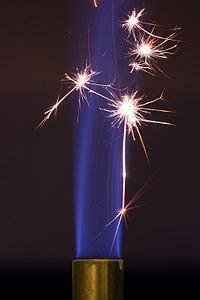
Photo from wikipedia
The reaction dynamics of the fluorine atom with vibrationally excited D2(v=1, j=0) was investigated using the crossed beam method. The scheme of stimulated Raman pumping was employed for preparation of… Click to show full abstract
The reaction dynamics of the fluorine atom with vibrationally excited D2(v=1, j=0) was investigated using the crossed beam method. The scheme of stimulated Raman pumping was employed for preparation of vibrationally excited D2 molecules. Contribution from the reaction of spin-orbit excited F*(2P1/2) with vibrationally excited D2 was not found. Reaction of spin-orbit ground F(2P3/2) with vibrationally excited D2 was measured and DF products populated in v′=2, 3, 4, 5 were observed. Compared with the vibrationally ground reaction, DF products from the vibrationally excited reaction of F(2P3/2)+D2(v=1, j=0) are rotationally “hotter”. Differential cross sections at four collision energies, ranging from 0.32 kcal/mol to 2.62 kcal/mol, were obtained. Backward scattering dominates for DF products in all vibrational levels at the lowest collision energy of 0.32 kcal/mol. As the collision energy increases, angular distribution of DF products gradually shifts from backward to sideway. The collision-energy dependence of differential cross section of DF(v′=5) at forward direction was also measured. Forward-scattered signal of DF(v′=5) appears at the collision energy of 1.0 kcal/mol, and becomes dominated at 2.62 kcal/mol.The reaction dynamics of the fluorine atom with vibrationally excited D2(v=1, j=0) was investigated using the crossed beam method. The scheme of stimulated Raman pumping was employed for preparation of vibrationally excited D2 molecules. Contribution from the reaction of spin-orbit excited F*(2P1/2) with vibrationally excited D2 was not found. Reaction of spin-orbit ground F(2P3/2) with vibrationally excited D2 was measured and DF products populated in v′=2, 3, 4, 5 were observed. Compared with the vibrationally ground reaction, DF products from the vibrationally excited reaction of F(2P3/2)+D2(v=1, j=0) are rotationally “hotter”. Differential cross sections at four collision energies, ranging from 0.32 kcal/mol to 2.62 kcal/mol, were obtained. Backward scattering dominates for DF products in all vibrational levels at the lowest collision energy of 0.32 kcal/mol. As the collision energy increases, angular distribution of DF products gradually shifts from backward to sideway. The collision-energy dependenc...
Journal Title: Chinese Journal of Chemical Physics
Year Published: 2019
Link to full text (if available)
Share on Social Media: Sign Up to like & get
recommendations!